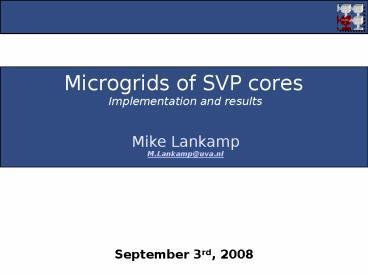Microgrids of SVP cores Implementation and results - PowerPoint PPT Presentation
1 / 22
Title:
Microgrids of SVP cores Implementation and results
Description:
Subsequent write to register will wake thread up ... Use SWCH in the program to avoid bubbles by switching before the miss is known ... – PowerPoint PPT presentation
Number of Views:77
Avg rating:3.0/5.0
Title: Microgrids of SVP cores Implementation and results
1
Microgrids of SVP cores Implementation and
results
- Mike Lankamp
- M.Lankamp_at_uva.nl
September 3rd, 2008
2
The Big Picture
3
Processor Components
- Register File
- Large around 1024 registers
- I-Structures thread-blocking reads
- Memory Caches
- Small caches because of latency-tolerant
architecture - Pipeline
- Threads Families
- Network
- Ring network for shareds, creates and globals
- Global delegation network
4
Register File
- Large Register File context for each thread
- Threads suspend on empty register by writing ID
into register - Asynchronous writebacks of long-latency
operations - Security Make sure the writeback comes from the
correct source
5
Virtual Register Mapping
6
Physical Register Mapping
7
Register State Transitions
8
Thread Management
- Threads are managed on two exclusive linked lists
- State list Ready, Waiting
- Membership list Empty, Member
- Various thread states
9
Pipeline
- In-order six-stage pipeline
- Write back Thread ID to register when read empty
- This suspends the thread on a data miss
- Subsequent write to register will wake thread up
- Dispatch long-latency operations instead of
waiting - Memory reads
- Floating point operations
- Results are written back asynchronously
- Thread switch on data miss
- Use SWCH in the program to avoid bubbles by
switching before the miss is known
10
Families and Threads
- Family Table (32 entries)
- Initial PC
- Parent info
- Dependencies
- Thread Table (256 entries)
- Current PC
- Register context info
- I-Cache info
11
Instruction Cache
- Ordinary, though small, cache
- Has fields (head, tail) for a linked list of
threads - i.e., threads waiting on the cache-line
- On cache-line loaded, all threads are activated
in 1 cycle - Reference counted
- When a thread requests the line, count increased
- When a thread suspends, count decreased
- When zero, line can be reused
12
Data Cache
- Ordinary, though small, cache
- Has fields (head, tail) for a linked list of
registers - i.e., register reads waiting on the cache-line
- Registers contain the read information (offset,
size) - On cache-line loaded, register reads are serviced
one by one - Special attention required for read/write-consiste
ncy - e.g., WAR, RAW, WAW, etc on cache-misses
- How about requests straddling cache line
boundaries?
13
Network
- Transfer shareds between neighboring processors
- Manage the create-token
- Broadcast creates (with globals)
- Manage various neighbor-to-neighbor
notifications, e.g. - Thread termination
- Family termination
- Synchronisation
14
Memory
- Processor doesnt care about memory
- It just sends tagged requests and receives
responses - Memory must guarantee tags with requests arrive
with the response - Tag is index of the cache-line where to place the
data - We plan on using the COMA memory
- Fits the computing model
15
Microgrid Simulator
- Emulates a configured cluster of microthreaded
processors - Based on the Alpha ISA
- Accepts flat and ELF Microthread Alpha binaries
- Produced by custom binutils-2.18
- Cycle-accurate
- Returns total execution time and several
statistics - Allows for stepping through the program
- Includes examining all processor components at
every cycle
16
Results
- Sine
- Fast Fourier Transform
- Ideal memory
- Banked memory
- Randomized banked memory
17
Sine
- 9-iteration Taylor expansion
18
FFT (Ideal)
- Double-precision complex FFT
- Performance for different N (log2 of input size)
19
FFT (Ideal)
- Double-precision complex FFT
- Speedup for up to 256 processors
20
FFT (Ideal)
- 4-processor Itanium-2 SMP
- Theoretical maximum performance of 24 GFLOPS at
1.5GHz - Maximum performance of 5.2 GFLOPS (22 of max)
- 28 microthreaded processors
- Theoretical maximum performance of 36 GFLOPS at
1.5GHz - Maximum performance of 14.4 GFLOPS (40 of max)
21
FFT (Banked MP)
- Conflicts on memory banks apparent
22
FFT (Random Banked M2P)
- Pseudo-random address-to-bank-mapping
- Conflicts on memory banks reduced































